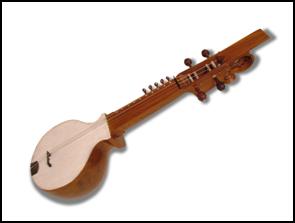 |
| Subject Expert |
: |
|
Dr. Gurnam Singh,
Professor, Department of Gurmat Sangeet
Punjabi University, Patiala |
| |
|
|
Dr. Kanwaljit Singh,
Assistant Professor,
Department of
Gurmat Sangeet,
Punjabi University, Patiala. |
| |
|
|
S. Amandeep Singh,
Assistant Professor,
Department of
Gurmat Sangeet,
Punjabi University, Patiala. |
| Translator |
|
|
Dr. Amanjot Kaur |
|
 |
| |
|
|
| |
In Gurmat Sangeet, alongwith singing tradition of Shabad keertan, an instrumental tradition is also in vogue. Guru Nanak Dev ji, the founder of Sikhism initiated his teachings with Shabad Kirtan1 presentations, with the accompaniment of rabab by Bhai Mardana Ji. During the tenure of all successor Gurus, various instruments became an integral part of Gurmat Sangeet tradition. Which include Stringed instruments like Rabab2 , Saranda3 , Saranda3 , Taus4, Dilruba5 , Taus4, Dilruba5 , Israj6 , Israj6 , Tamboora7 , Tamboora7 , percussion instruments like Mridang8, Pakhawaj9 etc; and modern instrument like Harmonium10 , percussion instruments like Mridang8, Pakhawaj9 etc; and modern instrument like Harmonium10 , Tabla11 etc are also being used in this tradition. , Tabla11 etc are also being used in this tradition. |
|
| |
|
|
| |
|
|
| |
|
|
| |
| Saranda |
|
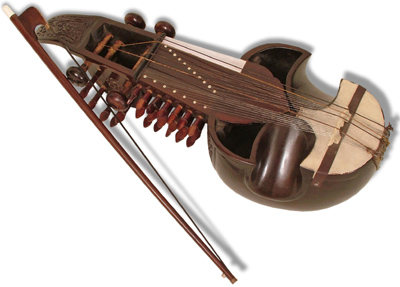 |
|
Saranda is a specially designed stringed instrument of Gurmat Sangeet tradition. It is believed that Guru Amardas Ji introduced Saranda in Gurmat Sangeet tradition and the fifth Guru Arjandev Ji contributed to propagate the use of this instrument in Shabad Kirtan presentations.
Saranda is suitable instrument for Kirtan tradition of the Sikhs. Due to its broad based toomba vessel, the sound of Saranda is enriched with bass tone. Owing to its peculiar design, it is one of the important instruments for Gurmat Sangeet presentations.  |
|
|
|
|
|
| |
|
|
| |
| Taus |
|
 |
|
Taus  is a special instrument of Shabad Kirtan tradition of Gurmat Sangeet. At first sight its shape and design, resembles a peacock, which attracts all and sundry.
In Persian peacock is called Taus. So this instrument is named Taus. Mayuri Veena   of Hindustani music is similar to Taus but with a difference in size. It is believed that Taus was introduced by Guru Hargobind Sahib ji, at Daroli Bhai Ki near Moga, (Punjab).
Taus is a suitable instrument for Shabad Kirtan tradition of Gurmat Sangeet. Due to its larger size the sound emerging from it is strong, heavy and soothing. Due to its sound qualities it is used to accompany Dhrupad 14 , Dhamar  and other similar singing styles.
Apart from the Kirtankaars of Guru-Kaal, Mahant Gajja Singh of district Firozpur, Bhai Kahn Singh Ragi of Patiala were the renowed musicians of this instrument. At present the department of Gurmat Sangeet, Punjabi University, Patiala is providing special classes to teach the playing techniques of Taus.  |
|
|
|
|
|
| |
|
|
| |
| Dilruba |
|
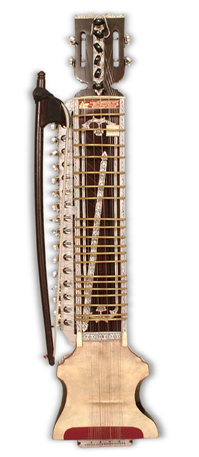
|
| |
Dilruba is a popular instrument of Gurmat Sangeet tradition. Its heart touching soothing tone, justifies its nomenclature. It is a bow instrument.
Dilruba is a useful instrument for Shabad Kirtan tradition of Gurmat Sangeet. wing to the small sized bridge (Javari) 15 the sound of Dilruba vibrates melodiously. Because of its basic structure, playing technique and sound it is a useful accompaniment instrument for the singing styles of Gurmat Sangeet.  |
|
|
|
|
|
| |
|
|
| |
| Israj |
|
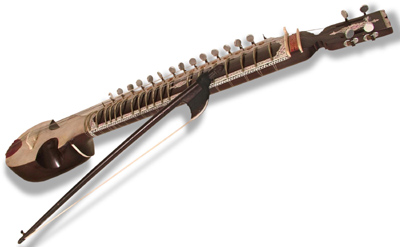 |
|
Israj is also one of the instruments used in Gurmat Sangeet tradition. It is a bow instrument. The structure of Israj is different from Dilruba and Taus. The lower part of its vessel is round having round shape, whereas the shape of Dilruba is straight. The sound of Israj as compared to Dilruba is composite of treble sounds. Due to its small size, it does not have a sound with broader reach. At present the Department of Gurmat Sangeet, Punjabi university, Patiala and other institutions of the world are imparting teaching of its playing techniques.  |
|
|
|
|
|
| |
|
|
| |
| Tamboora/Tanpura |
|
 |
|
Tamboora  is an important instrument being used in Shabad Kirtan presentation of Gurmat Sangeet. It is also called Tanpura. This instrumentes popularly used as music drone in Indian music tradition. Historically the origin of Tamboora is releated to the Rishi Toombroo. In the Sikh tradition of music, Tamboora was propagated and used in the time of Guru Gobind Singh Ji. At present it is considered as a basic, useful and melodic instrument to impart training of Raga based training of Gurmat Sangeet.
Tamboora is very useful instrument in the Shabad Kirtan of Gurmat Sangeet as it is a basically raga based tradition. With the harmonics relative combinations of the notes, the Tanpura provides all the notes of a natural scale. That is why all the ragas can be performed using this instrument. The world of Music also considers Tanpura as the mirror of singing notes, respected as correct intonation, effect and nature of swaras.  |
|
|
|
|
|
| |
|
|
| |
| Harmonium |
|
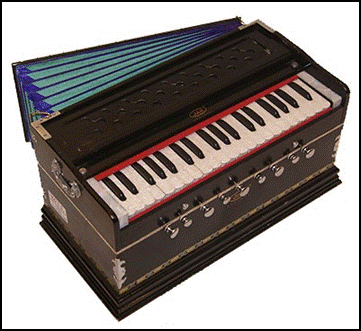 |
|
Harmonium entered the tradition of Gurmat Sangeet in 19th century. It is basically a western instrument, but due to its simple and easy playing technique, it is immensely used in Indian Music. Harmonium was improved to its present modal by Alexandre Debain of France, in 1840.
Harmonium is one of the instruments included in Indian music presentation during British rule. The tradition of stringed instruments was prevelent in Gurmat Sangeet, but due to its simplicity and easy mode of playing, it is frequently used in the tradition.  |
|
|
|
|
|
| |
|
|
| |
| Tabla |
|
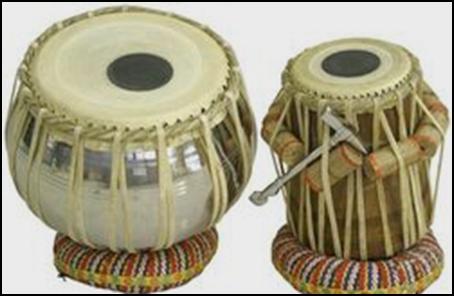 |
|
Tabla  is an important percussion instrument of Gurmat Sangeet as well as Indian music. It is being used in Gurmat Sangeet presentations for rhythm accompaniment. Its shape is similar to Bongo popular in Western music.
Tabla developed from Pakhawaj  an ancient percussion instrument of Indian music. After during the vessel of Mridangam or Pakhawaj divided into two pieces, placed horizontally, capped with membranes, the sound of the instrument was good and melodic. Thus the new instrument was named Jorhi/Tabla. The term is derived from Arabic word Tabl – a drum. It consists of a pair of drums and is played with both the hands. The Bigger sized drum (Dagga) produces bass whereas other (Madeen) gives treble sound.
Tabla is played with the extensive use of fingers and palm. While playing bigger drum of Tabla, the Dagga 16, the palm of the hand is used to apply pressure or sliding to improvise the pitch. The Varanas (syllables) of Tabla are played with various configurations to create a variety of sounds, speeds combinations.  |
|
|
|
|
|
| |
|
|
| |
| Jorhi |
|
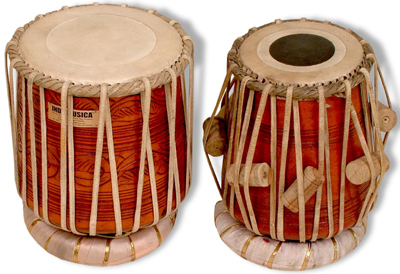 |
|
Jorhi is traditional percussion instrument of Gurmat Sangeet tradition. It is being used since Sikh Guru’s era, in the Shabad Kirtan performances. Designed from Pakhawaj Jorhi is a percussion instrument of medieval ages. After dividing the vessel Mridangam or Pakhawaj into two pieces, placed horizontal, capped with membranes, the sound of the instrument was good and melodic. Thus the new instrument was named Jorhi. It is considered as a pre version of Tabla.
In the present times Jorhi and Pakhawaj are played by applying a layer of dough of wheat, whereas membrane of Tabla has a permanent layer of black iron ore, specially designed and fixed over it. So it is evident that Tabla is the lateral version of jorhi.
Jorhi consists of a pair of drums, to be played with both the hands. The bigger drum produces bass whereas the Smaller gives treble sounds. Tabla is played with the extensive use of fingers and palm. While playing the bigger drum of Tabla, the Daggaa, the palm of the hand is used to apply pressure or slided to change the pitch.
Various Bols, the Varanas or syllables of Jorhi are played with various configurations to create a variety of sounds, speeds combinations.  |
|
|
|
|
|
| |
|
|
| |
| Pakhawaj/Mridang |
|
 |
|
Pakhawaj/Mridang was used by the Kirtankars of Gurmat Sangeet tradition. Guru Teg Bahadar Sahib used to play Mridang. His personal mridang, presented to Bhai Gurbax as a blessing is still preserved at Gurduwara Sahib, Mridangawali, Jaunpur.
This instrument belongs to the category of ancient percussion instrument of music tradition of Punjab. It is also called Mridang. Pakhawaj is a double ended barrel drum made out of light wood. This instrument is played by hands and the meaning of Mridang is body of clay so this instrument is made of clay. Lala Bhawani Singh of Hoshiarpur taught the art of playing these instruments to Kadau Singh.
It is made of a hollow wooden vessel of about three feet long, narrowed at the edges. It is covered with leather membranes tied with a long strap of leather strip. On the Left membrane a layer of dough of wheat flour is applied to get low pitched, bass enriched sound. The right hand membrane is comparatively smaller in size and is made of specially designed circle shaped round black layer of iron ore. It produces high pitch sound enriched with treble.
The playing technique of Pakhawaj resembles the style of Jorhi, a popular percussion instrument of Gurmat Sangeet tradition. At present the Department of Gurmat Sangeet, Punjabi University, Patiala is making laudable efforts to preserve and propagate the tradition of Pakhawaj in Punjab again. m |
|
|
|
|
|
| |
|
|
|
| |
|
|
| |
| 1. Shabad Kirtan |
: |
Singing shabad compositions of bani in raagas according to the conventions in Sikh religion. |
| 2. Rabab |
|
A plected string instrument which iused to be played by Bhai Mardana in Gurmat. |
| 3.Sarnda |
|
A bow string instrument. |
| 4. Taus |
|
A bowed string instrument in the shape of a peacock prevalent in Sikh music tradition. |
| 5. Dilruba |
|
A bowed string instrument . |
| 6. Israj |
|
A bowed string instrument. |
| 7. Tambura |
|
A String instrument to provide drone in Indian Classical music since ancient times |
| 8. Mridang |
|
An ancient Indian percussion instrument (Pakhavaj). |
| 9. Pakhavaj |
|
A percussion instruments in Indian music. |
| 10. Harmonium |
|
A wind instrument producing sound on the basis of equally tempered scale. |
| 11. Tabla |
|
A rhythmic percussion instrument. |
| 12. Gurmat Sangeet |
|
A tradition of shabad Kirtan founded by Sikh Gurus following the musicology of Guru Granth Sahib. |
13. Javah  |
|
A wooden or elephant tusk plectrum used for playing rabab. |
| 14. Dharupad |
|
A Classical singing style in indian music. |
| 15. Javari |
|
The upper part of rectangular bridge for passing strings over it, in the string instruments. |
| 16. Dagga |
|
A lower pitch part of tabla - A jorhi |
|
|
| |
|
|
|
| |
|
|
| |
1 Rabab belongs to the catagory of ?
I. Wind Instrument II. A bowed String Instrument
III. Plucked String Instrument IV. None of these.
2 Who was Bhai Mardana ?
I. A Tabla Player II. A Companion of Guru Nanak
III. A Raagi IV. A poet
3. Saranda is.
I. A Raaga II. A bowed String Instrument
III. Plucked String Instrument IV. None of these.
4. Taus belongs to the catagory of ?
I. A bowed String Instrument II. Wind Instrument
III. Plucked String Instrument IV. None of these.
5. With Which bird the Taus resembles ?
I. .Hawk II..Peacock III..Papiha IV. .Koel
6. Dilruba is played with.
I..Gaz II. .Mizrab III..Javha IV. .None of these
7. Tamboora is releated to.
I. A Raaga II. A Plucked Instrument
III. A bowed String Instrument. IV. A Taala
8. In which era was Jorhi included in the tradition of percussion instrument of Gurmat Sangeet.
I. The present times II. Sikh Guru's era
III. Vedic period IV. Modern era
9. Mridang belongs to which guru.
I. Guru Nanak Dev ji II. Guru Amardas ji
III. Guru Teg Bahadar Sahib IV. Guru Gobind Singh ji
10. Mirdang Instrument belongs to the category of ?
I. A bowed String Instrument II. Wind Instrument
III. Plucked String Instrument IV. None of these. |
|
| |
|
|
| |
 |
|
| |
|
|
| |
|
|
| |
|
|
|
| |
|
|
| |
1. Encyclopaedic Dictionary of Music, Vol 1-2, Ashish Pandey (Edi.), Isha Books, Delhi, 2005.
2 Guru Shabad Ratnakar Mahan Kosh, Kahan Singh Nabha (Bhai), Language Department, Punjab, 2006.
3 Gurmat Sangeet Terminolgy, Gurnam Singh (Dr.), (Chief Edi.), Pujnabi University, Patiala. 2012
4. Gurmat Sangeet Prabandh te Pasaar, Punjabi University, Patiala. 2000
|
|
| |
|
|
|



